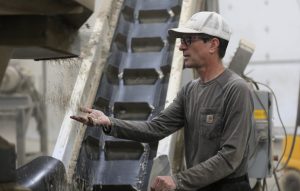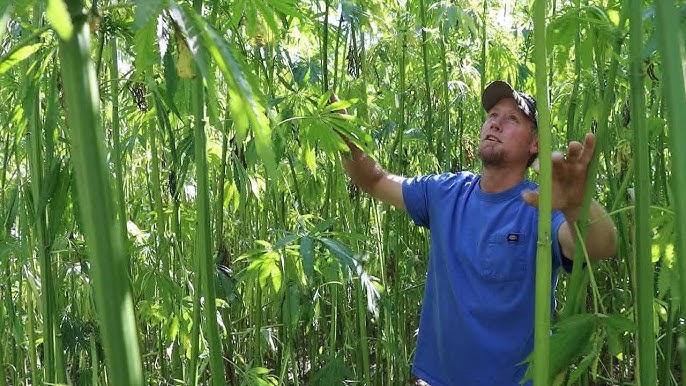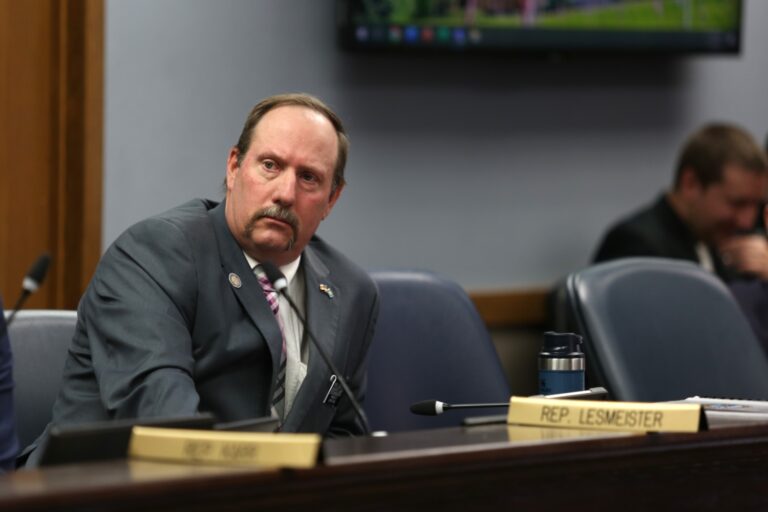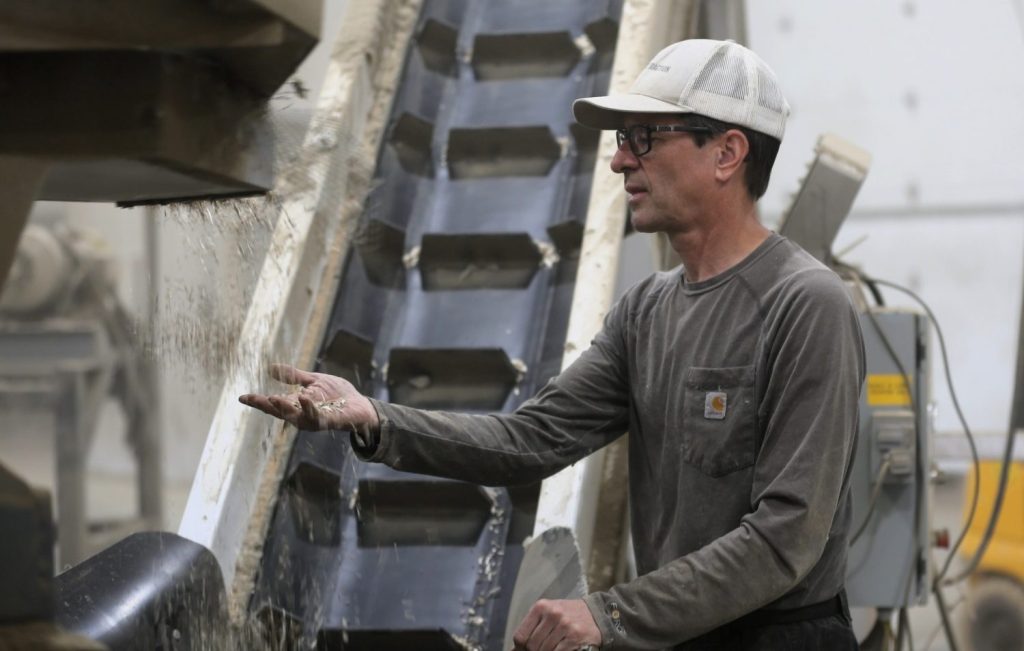
Advocates say industry holds potential to sequester carbon, bring jobs to small towns
WINFRED — Ken Meyer’s boots imprint the fine layer of dust settled over the concrete floor as he walks through South Dakota’s first industrial hemp processing facility.
It’s loud. Fans whirl and machinery grinds. Strips of sunlight cut through the haze.
Piles of dry hemp stalks line one wall. Meyer gestures toward a forklift feeding one of the piles into an industrial contraption.
On one side of the machine, fiber pours out in tangled ribbons. On another, chunks of the woody core, called “hurd,” tumble into a large sack atop a pallet. Meyer reaches in and raises a handful.
“We can turn hemp stalks into materials for animal bedding, hempcrete, bioplastics, you name it,” he said. “Right here in South Dakota.”
Meyer has a vision. He said expanding the hemp supply chain in South Dakota will bring more small processing and manufacturing into the state, and pull heat-trapping carbon dioxide from the atmosphere.
“Hemp absorbs carbon as it grows, and we can lock the carbon into the various materials produced,” Meyer said. “And all that manufacturing could happen here in South Dakota.”
But coordinating the investments, infrastructure, oversight and market development needed to realize that vision is more work than Meyer alone can accomplish with his company, Complete Hemp Processing.
In Wakonda, John Peterson with Dakota Hemp is not only constructing the state’s second processing facility but is also a hemp farmer.

“We can’t just have everybody start planting hemp,” Peterson said. “You need the whole chain — growers, processors, and manufacturers — to come online at the same time. And that’s hard.”
Hemp and carbon
South Dakotans have only been growing hemp since 2021. The state is now the No. 1 hemp producer in the country, with 3,700 acres harvested in 2024. To capitalize on hemp’s potential to sequester carbon dioxide and keep it from trapping heat in the atmosphere, millions more acres are needed.
Hemp can grow 16 feet tall in three months. Growing a field of 16-foot-high stalks requires a lot of photosynthesis, which is the way plants absorb carbon dioxide and water to convert sunlight into energy for growth. An acre of hemp stalks absorbs approximately 5.5 tons of carbon per acre each season, according to Brittany McKell, with Hemp Carbon Standard in Canada. She said an additional ton of CO2 per acre is stored in the soil if less invasive tillage practices are used.
Hemp Carbon Standard works with farmers to quantify the amount of carbon sequestered by their hemp farm and convert that to credits. Those are sold on global, private carbon markets where companies and individuals purchase them to offset their greenhouse gas emissions. The company then shares those profits back with farmers. Peterson recently signed up and earned 367 carbon credits on one year’s harvest, which can be sold for over $100 each.
While corn stalks can temporarily store up to about 4 tons of above-ground carbon dioxide per acre, most of it is re-released through digestion and decay.
Decay happens to harvested hemp, too. Keeping the carbon in the hemp stalks requires a longer-term carbon storage solution: processing those stalks into long-lasting materials. Hemp’s utility extends to everything from bioplastics and lumber to textiles and insulation. Hempcrete, for example, is a construction material made from hemp hurd and lime that absorbs CO2 as it sets.
Hemp Carbon Standard promotes the use of those products, too, because McKell said they serve as sustainable, less carbon-intensive alternatives that indirectly offset the production of their more carbon-intensive counterparts: oil-based plastics, wood from trees and energy-intensive construction materials. Depending on the product being made, McKell said, the impact of producing hemp-based, less carbon-intensive alternatives prevents another 9 to 18 tons of CO2 from entering the atmosphere, per acre of hemp allocated to the production of the material.
The numbers mean that if 18% of South Dakota’s approximately 18.5 million cropland acres grew hemp every summer, the hemp stalks — not counting the carbon potentially stored in the soil or the material offset of producing less carbon-intensive materials — would remove over 18 million tons of atmospheric carbon per year. That’s as much as a proposal in South Dakota aiming to achieve a similar vision: Summit Carbon Solution’s carbon sequestration pipeline, which would annually capture up to 18 million tons of carbon emissions from 57 ethanol plants in five states. The five-state project has faced numerous regulatory and legal hurdles, along with opposition from landowners refusing to grant access and expressing concerns about potential leaks of toxic carbon dioxide plumes.
Farmers with land crossed by the pipeline would receive easement payments. In hemp production, farmers can capitalize the carbon-storage potential of their crop by selling carbon credits. Hemp also requires no herbicides, unlike other row crops such as corn and soybeans.
Despite its potential, the hemp market faces regulatory challenges. And industrial hemp advocates say getting hemp this far was not easy.
The fight to legalize hemp
Although hemp was federally legalized under the 2018 farm bill — which defined hemp as cannabis containing no more than 0.3% tetrahydrocannabinol (known as TCH, which results in a high at greater concentrations) — South Dakota did not immediately follow suit.
Early efforts to legalize hemp production at the state level were met with resistance, particularly from former Gov. Kristi Noem’s administration, which expressed concern that legal hemp could lead to broader marijuana legalization. Oren Lesmeister, a rancher and Democratic former legislator from Parade, spent years fighting to get the hemp industry rolling in South Dakota.

“There was this fear that everyone was going to run out and get stoned,” Lesmeister said. “We had to beat that misconception with education and persistence.”
The legal and regulatory barriers fell in several stages. The first major step was ensuring that South Dakota’s laws aligned with federal standards legalizing the crop, something the 2018 farm bill allowed states to do.
Implementation in South Dakota lagged, with hemp cultivation beginning in 2021 after state administrative rules were finalized and approved. Even then, regulatory burdens remained. But Meyer said many of these initial state restrictions have since been scaled back as South Dakota gained experience with the crop.
Meyer said the two major impediments still in place are THC testing requirements and criminal background checks. He hopes those requirements will be loosened in the next federal farm bill.
Selling a bottom-up vision
Lesmeister sees parallels with corn-based ethanol, which grew into a major industry with help from the federal government. It created a guaranteed market through the Renewable Fuel Standard, which requires refiners to blend billions of gallons of ethanol into gasoline each year or buy credits. The number of corn acres in South Dakota went from about 4 million before the standard was enacted to about 6 million last year.
“Hemp got this far without any of that,” Lesmeister said. “But imagine where it could be with a little help.”
Doug Sombke, president of the South Dakota Farmers Union, sees helping the emerging hemp industry as a better way to sequester carbon than controversial proposals to capture carbon emitted by ethanol plants.
“If you really want to support the climate and agriculture, get that money to the people working the land,” Sombke said.
Bryan Jorgensen is a regenerative farmer and soil health expert from Ideal. He is skeptical that climate change requires government action. But Jorgensen does see industrial hemp as a chance to rebuild rural communities as part of America’s manufacturing base.
“This could localize manufacturing,” he said. “But it takes vision and the will to invest in producers instead of propping up extractive systems.”
By comparison, he sees carbon pipelines as an extension of a flawed farm economy that has become overly dependent on corn and soybeans, partly due to the federal support for those crops.
“We’ve created this monster,” Jorgensen said. “We’ve invested billions in learning how to grow corn, so now we don’t know how to do anything else. And farmers are stuck in a system where they’re not even the ones benefiting.”
Silvia Secchi, a professor at the University of Iowa who studies agricultural and climate policy, agrees.
“We subsidized the corn, not the farmer,” she said. “That’s the problem.”
For now, the few thousand acres of hemp grown in South Dakota pale in comparison to about 6 million acres of corn and 5 million acres of soybeans. But advocates believe that could change rapidly if hemp processors and manufacturers move in, and the U.S. government backs the vision.
“There’s a real opportunity here,” said Karll Lecher, co-founder of Dakota Hemp. “We just need more boots on the ground.”





